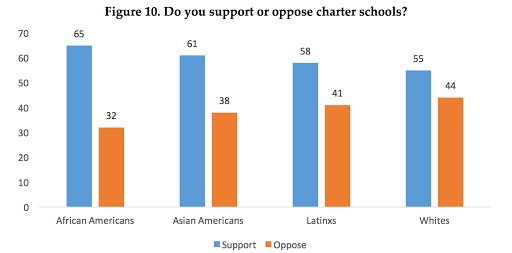Millennials: The School Choice Generation
 Millennials are likely the most studied and talked about generation to date. And it’s no secret this generation has some pejorative connotations associated with them. Just type “Millennials are…” into a Google search bar.
Millennials are likely the most studied and talked about generation to date. And it’s no secret this generation has some pejorative connotations associated with them. Just type “Millennials are…” into a Google search bar.
But amid the easy stereotypes and bad rap, Millennials recognize the importance of educational freedom.
A recent GenForward survey confirms support for school choice is high among Millennials across racial and ethnic lines. The bimonthly survey of Millennials is conducted by researchers at the University of Chicago. Over 1,750 young adults between the ages 18 and 34 were asked about education in the United States and responded favorably toward voucher programs and charter schools.

GenForward found among Millennials, 79 percent of African Americans, 76 percent of Asian Americans, 77 percent of Latinos, and 66 percent of whites support vouchers for low-income students to attend private schools. In addition, 65 percent of Millennial-age African Americans, 61 percent of Asian Americans, 58 percent of Latinos, and 55 percent of whites support charter schools.
This is not the only survey with these results. In January, Beck Research—a left-leaning polling company—conducted an annual National School Choice Poll among likely 2018 November voters and reported 75 percent of Millennials support school choice and back many forms of educational choice, including charter schools and scholarship tax credits.
As a Millennial myself, these results do not surprise me.
My generation has grown up with having plenty of options in everyday life—including education. The development of charter schools and voucher programs started taking root as I was about to start going to school. I experienced first-hand the power of parental choice: I attended private elementary schools, the local public high school for a couple of classes while I was homeschooled, and then a different private school for the rest of high school—I even “attended” an online school for a year. All to find the right educational setting where I could best thrive.
After college, I taught summer school at a public elementary school before teaching full time at a charter school where I served primarily low-income and minority families. Many of these families chose to leave their neighborhood schools in search of a learning environment where their students’ needs were better served. A mother told me she was grateful her son was at a school where second language support was provided in tandem with the content curriculum. She also appreciated the elevated levels of communication and family engagement.
This is not to say all public schools are “bad”—my older sister, for example, is doing amazing things with her students in a public school setting. However, that doesn’t mean this setting helps all students succeed.
Families realize “one size doesn’t fit all” in education. And school choice empowers them—not zip codes—to choose what size fits their child best.
Yet opponents of school choice—powerful interest groups i.e., teachers’ unions—persist and ignore the voices of those they claim to fight for, going so far as to label anyone who supports alternatives to the traditional public system as racist. (More about that here.) Ironic, considering minorities strongly support alternative education options and the freedom to choose these options.
A shift in the power dynamics of education is on the horizon.
As the largest generation right now, Millennials are a rising influence and can change the course of education by demanding the expansion of choice programs. Now that’s an association to be proud of.